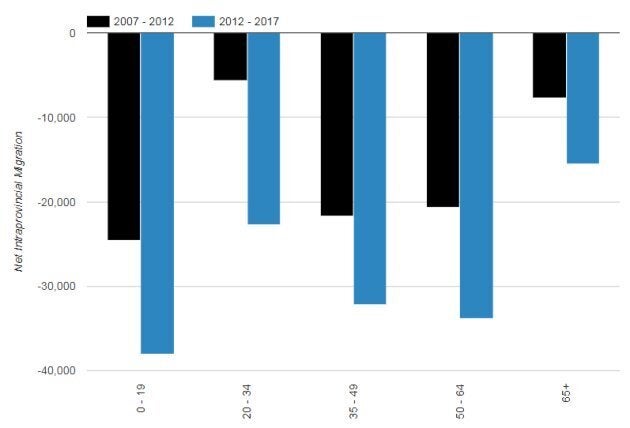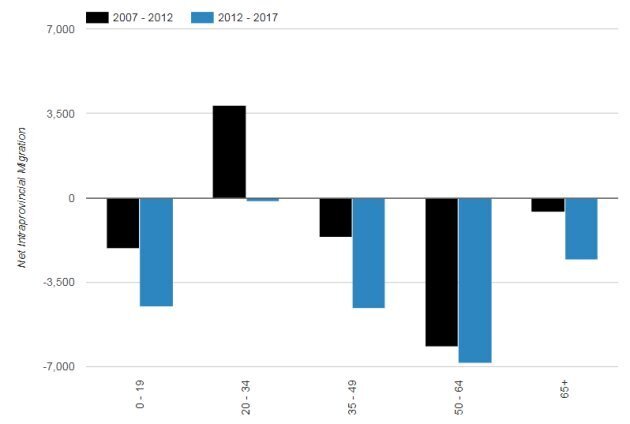
Better Dwelling: Local Millennials have had enough of Toronto and Vancouver, and are starting to leave. Statistics Canada's latest intraprovincial migration numbers show that the number of people leaving the cities for different parts of the province is accelerating. The trend is showing huge growth in the crucial millennial demographic. A demographic that will be entering their prime earning and home-buying years soon. That's no bueno.
Net intraprovincial migration
Net intraprovincial migration is the total change of people that left the city for another part of the province. That is, if one person from rural Ontario moves to Toronto, and zero people leave Toronto, the net intraprovincial migration is one. If one person moves to Ontario, and three people from Toronto move to Hamilton, the net intraprovincial migration is minus-2. Ideally a region attracts more people from other parts of the province than they lose. This number is different from immigration, but is just as important.
Convincing people to immigrate to a city is good, but retaining people is even better. After all, cities are built to serve people, not serve as an advertisement for immigration that may be disappointing people once they arrive. A drastic change in these numbers could indicate an underlying problem that isn't being reflected in current government stats.
Toronto loses over 142,000 people to other parts of Ontario
Toronto is seeing its net intraprovincial migration numbers plummet, and that's bad. From 2012 to 2017, the net intraprovincial migration was minus-142,465, a 77.53 per cent larger loss than the period before. This means over 142,000 more people left Toronto for other parts of the province than Toronto attracted. This pace is a lot higher than the pace of population growth.
Toronto net intraprovincial migration
More people are leaving Toronto for other (cheaper) parts of Ontario.

Source: Statistics Canada, Better Dwelling.
Breaking that down by age brackets, the trend is a little worse than you may anticipate. The 20 to 34 year old age bracket (millennials) saw a net decline 306.28% larger than the period before. To contrast, the 35- to 49-year age bracket saw a net decline 48.52 per cent larger than the period before. Toronto is losing young people at a very rapid pace, to other parts of the province.
Lower Mainland (including Vancouver) loses over 18,000 people to other parts of B.C.
The Lower Mainland, the densely populated part of British Columbia, is doing better than Toronto, but still not great. From 2012 to 2017 the region saw a net migration of minus-18,670 people, a loss that was 180 per cent larger than the period before. The number seems relatively small, but it's a province with a population smaller than Greater Toronto. The net loss to other regions represents a huge increase.
Lower Mainland net intraprovincial migration
More people are leaving Lower Mainland for other (cheaper) parts of British Columbia.

Two interesting demographics are changing in the province. The largest loss was in seniors, who are likely cashing in and seeking greener pastures. The 65-plus demographic showed a net migration of minus-2,575, a whopping 344.73 per cent more people compared to the period before. The 20-to-34 demographic saw net intraprovincial migration reach minus-139, a 103.64 per cent decrease from the period before. This demographic was previously the only demographic not in decline across the region.
The real irony here is these two regions spend huge amounts of cash to attract millennial immigrants. At this point, millennials should be putting down roots and entering their prime earning years. Retaining millennials is typically a win for both the local economy, as well as birth rates in the region. Maybe someone should teach local politicians about the concept of retention?
This article originally appeared at Better Dwelling. Follow them on Facebook.
Also on HuffPost: